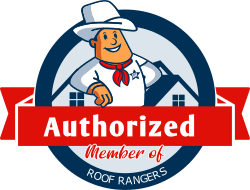Recovery from a Texas Storm.
Texas storms may be fierce and cause significant damage to outdoor structures and homes. After a hailstorm, you want to see how the hail affected your property – especially your gutters.
Gutters are especially susceptible to hailstorms because they are exposed and typically are made of easily dented materials, such as aluminum. Dented or misshapen gutters are unsightly and can also prevent water from flowing properly, causing overflow and possible water damage around your home’s foundation. Check for dents, cracks, or sagging sections after a storm to see if they show hail impact.
Hail may also loosen gutter fasteners or knock sections out of place. This can lead to leaks or separation from the roofline, reducing the effectiveness of your drainage system. Check the downspouts as well, as debris from the storm may cause water to back up and over the edges. Quick inspection and repair can prevent costly repairs down the road.
Understanding Hail Damage.
What is Hail Damage?
Hail damage varies widely depending on the size of hailstones. Tiny hailstones of about 1/2 inch in diameter could cause limited cosmetic damage, like small scratches or dents which are often repairable. But bigger hailstones of 1 to 3 inches in diameter can crack windows, pierce roofs and destroy crops. The impact is more intense the larger the hailstone, so homeowners and businesses should consider the risk based on local weather conditions especially during peak storm seasons.
Wind speed also affects the amount of hail damage. High winds can make hailstones fly faster off surfaces. This could result in more dangerous impacts as dents in automobiles, a smashed roof or broken windows. The durability of materials affected by hail also affects the severity of the damage. For example, softer materials like wood or vinyl siding may be more damaged by hail than harder surfaces like metal or concrete. In the end, understanding the combination of hail size, wind speed, and materials exposed to these forces is critical in determining the hail damage risk.
How Gutters Are Vulnerable.
Gutters are especially susceptible to hail damage because they are installed along the roofline and are not protected from direct impact. Since gutters are designed to channel water, a structural weakness caused by hail can compromise their function and cause larger home maintenance issues.
In addition to the physical damage that hail directs to gutters, the impact of large hailstones can leave dents, cracks or holes in the gutter system. These weaknesses prevent the gutters from diverting water away from the home, causing possible overflow during rainstorms. If these issues aren’t addressed, ultimately water seeps into the foundation and also results in erosion or flooding in basements and crawl spaces. This compromises the structural integrity of the home and causes costly repairs.
In addition, improperly functioning gutters can leak water into other areas of the home. When gutters are clogged or damaged by hail, water can pool around the roofline and create rot or mold on the siding and fascia. The excess water may also ruin the landscaping, wash away soil and crack driveways and walkways. Gutters should be regularly inspected and maintained after severe weather, especially hailstorms, to avoid them from becoming a more serious and costly problem.
Signs of Gutter Damage from a Hailstorm.
Cracks and Holes.
With enough force, hailstones can break gutters and create small holes that cause leaks and poor drainage. Even tiny fractures can grow over time and cause significant water damage to your home’s foundation and siding.
Along with the immediate harm brought on by hailstones themselves, the cumulative effects of these small fractures can cause more serious problems if left untreated soon. As water enters the hole or crack, the gutter system may pull away from the roof or sag under the pressure of accumulated water. This raises the risk that water will gather close to the foundation and result in soil erosion or craters in the foundation itself. With time, they can be a little more expensive and difficult to repair, so regular gutter maintenance and prompt repairs are vital to avoid costly structural damage later on.
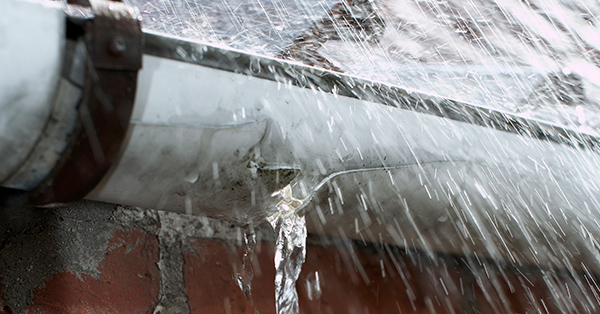
Rust and Corrosion.
Metal gutters are prone to rust and corrosion when the coating is damaged by hail. Rust weakens the gutters over time and increases the risk that they will leak and fail.
When hail hits metal gutters, it makes little dents and nicks in the covering, leaving the metal exposed to the elements. When the coating is worn away, water might seep in and accelerate rust formation. Over time this corrosion spreads and weakens the gutters, making them more susceptible to further damage. If rust is not treated, the gutters may fail completely and require repairs or replacements. Also, corroded gutters may become clogged with debris and impair water flow and cause damage to the roof, foundation and landscape around it.
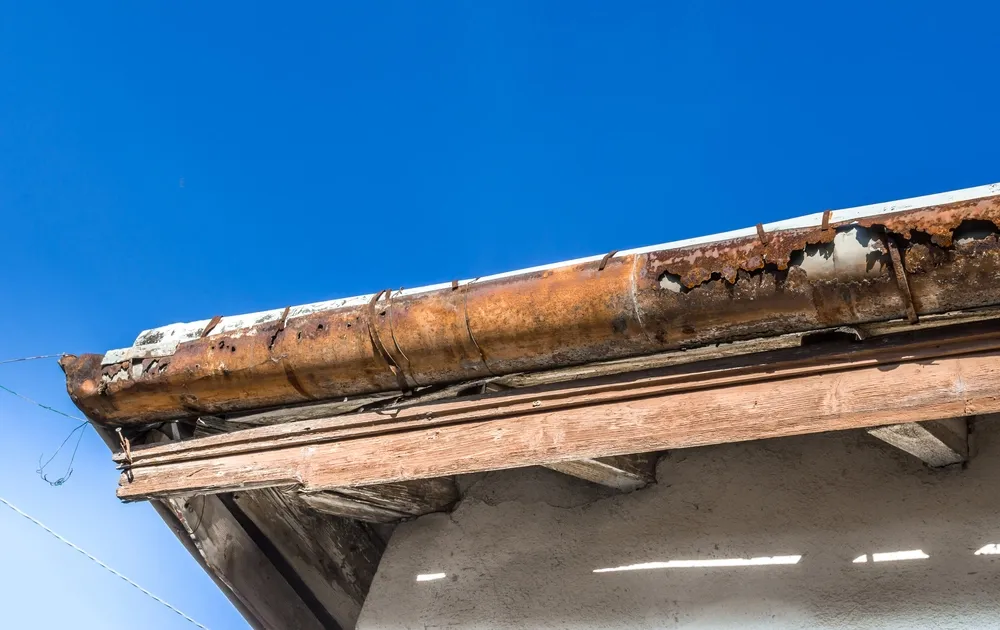
Visible Dents & Dings.
The aluminum and copper gutters will often have dents and dings from hail impact. Minor dents do not affect functionality immediately, but severe damage can affect water flow and reduce the performance of the gutter system. Water from clogged gutters can seep into walls, causing peeling paint, mold growth, and drywall degradation. This hidden moisture weakens the interior structure and causes costly repairs and renovations.
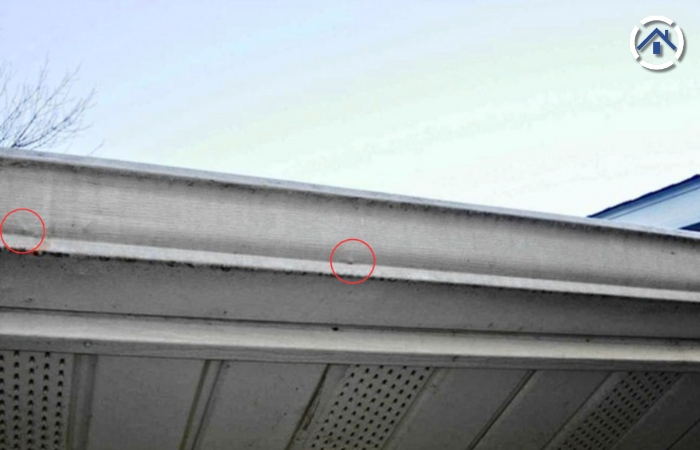
Improper Water Flow.
Dented or cracked gutters can keep rainwater from flowing away from your home. This can cause water overflow and cause flooding around your foundation and landscaping.
Damaged gutters can also cause your home to lose its exterior appearance. Water that isn’t directed away from the roofline may pool against the walls and windows and cause rot, mold growth, and siding or paint damage. Over time, this excess moisture can weaken your foundation and cause costly repairs and compromise the structural integrity of your home. Gutter maintenance and timely repairs are necessary to prevent these problems from occurring over time.
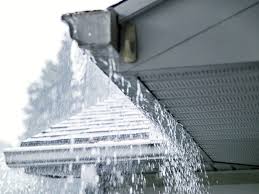
Downspout clogged.
Strong winds from hailstorms often blow debris like leaves and twigs into your gutters and downspouts. If unattended, this debris can clog the system and prevent water from draining properly and causing backups.
Clogged downspouts and gutters can also cause other issues such as roof damage, foundation issues and pest infestations. If water can’t flow through the system, it might overflow and pool around your home’s foundation. This excess moisture may damage the foundation, seep into the basement or even result in structural damage. Moreover, trapped debris may provide a breeding ground for mold, algae and insects, making the cleanup more expensive and time consuming later on. Gutter maintenance should be done regularly to avoid these problems.
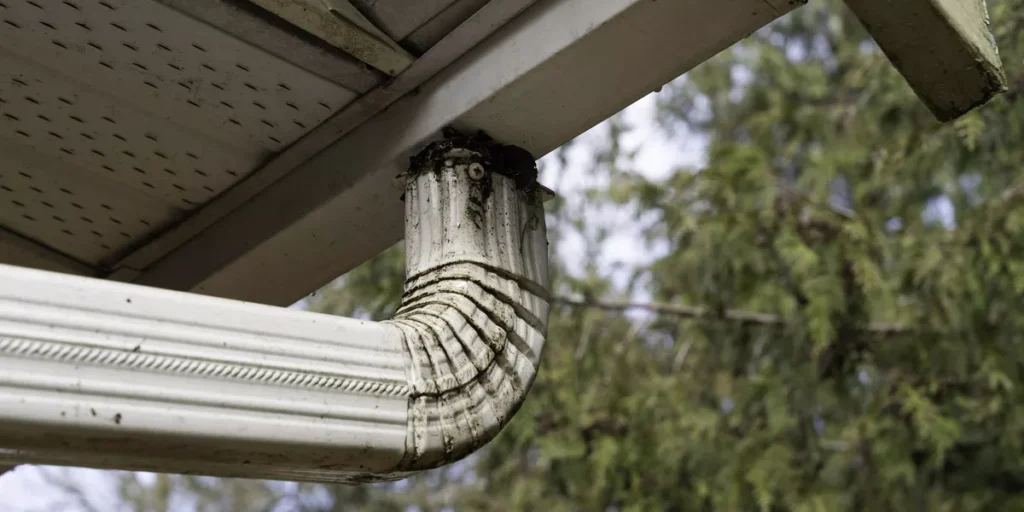
Sagging or Misaligned Gutters.
Hail impact may pull gutter brackets and fasteners loose and cause gutters to sag or misalign. If gutters aren’t properly spaced, water can pour over the edges and cause erosion and possibly damage to your home’s exterior.
Also, when gutters are misaligned or damaged by hail impact, they may also become clogged with debris more easily because water is no longer flowing smoothly or directed correctly. This blockage can cause water to sit in the gutters, causing rust and deterioration. Over time, prolonged moisture exposure can weaken the gutter system and make it susceptible to additional damage from future storms. The compromised gutters may eventually allow water to seep into the roof, wall, or foundation, causing both expensive repairs and possible structural damage to the home.
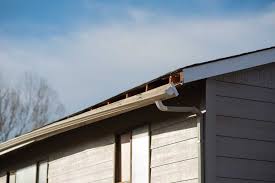
How to Fix Common Gutter Problems.
Sealing Cracks and Holes.
Small cracks and holes can be patched with waterproof sealant to stop leaks. For larger holes, gutter patches or replacing parts of the gutter may be necessary.
The best waterproof sealant or gutter patch will depend largely on the material of your gutters (aluminum, steel, copper, vinyl) and the severity of the damage. But here are some highly rated options:
Liquid Rubber Sealant:
- Best for: Sealing cracks, holes, and seams in gutters, especially larger or wider gaps.
Silicone Sealant:
- Best for: Long-lasting, flexible, waterproof seals.
Gutter Patch Kits:
- Best for: Larger holes or parts of damage.
Butyl Rubber Tape:
- Best for: Temporary repairs and quick fixes for small holes or leaks.
Epoxy or Polyester Resin:
- Best for: Structural repairs or if the gutter material is badly damaged and needs reinforcement.
Clean the gutters thoroughly prior to applying any sealant or patch, as dirt and debris may inhibit adhesion. In case the damage is substantial, replacing a section of the gutter could be more efficient than patching.
Rust and Corrosion Treatment.
A rust-resistant primer and sealant can extend the life of metal gutters. If corrosion is extensive, replacing the affected section may be the best solution.
In addition to applying a rust-resistant primer and sealant, maintenance of metal gutters is important to prevent further deterioration. Cleaning gutters of debris, leaves, and dirt helps prevent water from accumulating and rust formation. Visiting the gutters periodically to check for damage such as cracks, holes or rust spots allows homeowners to fix small problems before they become big problems. In the event the corrosion could not be fixed, replacing the damaged section with a brand new, long lasting material could be required to maintain the whole gutter system working properly and stopping even more water damage on the house.
Repairing Dents and Dings.
Minor dents can often be repaired with a rubber mallet to reshape the gutter. If the dented area impairs water flow, though, replacing the damaged section may be necessary.
When the dent is much more serious or the gutter material is damaged, a rubber mallet might not be enough to restore the form. For deeper dents or dents that have created cracks, the gutter system can become weakened and leaks may occur or the structure may collapse. In these instances, it might be necessary in order to replace the whole section to ensure proper function and also to stay away from further damage to nearby areas. Regular inspection and maintenance may catch such issues early and reduce the need for repairs or replacements.
Restoring Proper Water Flow.
Clearing blockages and sloped gutters will help maintain good water drainage. Checking for obstructions regularly will prevent future problems.
Clearing blockages and maintaining sloped gutters also means making sure downspouts are free of debris and connected properly. Downspouts direct water away from your home’s foundation, so a blockage or misalignment can cause water damage and erosion. Cleaning and inspecting the entire gutter system (including the downspouts) regularly keeps rainwater flowing freely and prevents costly repairs down the road.
Clogged Downspouts Clearing.
With a hose or plumber’s snake, debris can be pushed out of clogged downspouts to reroute the water. Future buildup can be prevented by installing gutter guards.
You can also use a hose or plumber’s snake to clear clogged downspouts but you should also regularly clean your gutters to avoid future blockages. Cleaning gutters more than two times a year – in the spring and in the fall – keeps leaves, twigs along with other debris from accumulating and clogging them. For homes near trees, more frequent cleaning may be needed. Gutter guards or covers can help prevent debris accumulation, allowing water to flow freely without the need for frequent cleaning and prolonging the life of your gutters and downspouts.
Fixing Sagging and Misaligned Gutters.
Loosening loose brackets and re-aligning will restore the function of your gutters. If the damage is substantial, the brackets or parts of the gutter might have to be replaced.
If the brackets are too rusted or bent beyond repair, they must be replaced with new, tough ones to keep the gutter system working properly. Using quality materials for the replacement parts can prevent future damage and prolong the life of the gutters. Inspect the gutters for other problems such as clogs or cracks that could affect performance. Regular maintenance and repairs will keep your gutters working efficiently to avoid water damage to your home.
Problems with Granule Accumulation.
Removing excess granules from gutters will prevent clogs and improve water flow. Checking your roof for more damage can also help prevent more granules from building up in the future.
Along with removing excess granules, you should also check your gutters frequently for debris buildup and signs of wear. Over time, twigs, leaves, and dirt can cause clogs and restrict water flow. By keeping gutters clean, water does not back up, causing costly damage to your roof and foundation. And having your gutters properly aligned and attached can help prevent water pooling and other long-term problems.
What to Do Next After Spotting Hail Damage on Your Gutter.
Perform a Full Inspection.
After a storm, check your gutters and roof for hail damage such as cracks, dents and water leaks. A thorough inspection will uncover problems before they get worse.
Check nearby areas for debris such as fallen tree branches or loose shingles that may cause more damage besides visible damage. Watch the gutters as well; If they become clogged with leaves, twigs, or hail, water may back up and cause leaks or other structural problems. Taking action now to clean up and fix damage will prevent costly repairs down the road and preserve the integrity of your home. Regular maintenance after storms keeps your roof and gutters working properly and preventing future weather damage to your home.
Document the Damage.
Take clear photos of all damaged areas, as this information may help with an insurance claim. Keeping records of previous inspections can also show the impact of the storm.
Moreover , document the date & time the photographs were taken so it can offer a timeline of the damage. Take close-up shots of specific problems like roof leaks, broken windows or structural damage, and wider shots if possible. A detailed record of the damage may be helpful to your insurance company during claims so you get paid for the losses you suffered.
Contact Your Insurance Company.
Report damage to your insurance provider as soon as possible to determine coverage options. Complete documentation will streamline claims and ensure you get paid for needed repairs.
Provide your insurer with as much detail as possible when reporting damage – photos, descriptions, and any receipts or maintenance records. Timely and thorough documentation will expedite the claims process and reduce the risk of delays or disputes. Being proactive helps the insurance company assess the damage and ensure you get the maximum payout for needed repairs or replacements.
Seek Advice from Professionals.
Hire a professional gutter repair company to assess damage and repair it. Experts can also recommend ways to prevent future hail damage.
A professional gutter repair company can also advise you on maintenance to extend the life of your gutters. They may recommend installing impact-resistant materials or strengthening existing systems to better withstand future hailstorms. Regular inspections and cleaning are also preventative measures that can help reduce damage from severe weather and keep your gutters working year round. By addressing potential weak spots early on, you can save money in the long haul on costly repairs and replacements.
How to Avoid Gutter Hail Damage.
Install Heavy-Duty Gutters.
Choosing gutters made of durable materials such as steel or copper can increase resistance to hail impact. Reinforced gutters offer greater protection and durability in hail-prone areas.
Other materials, such as aluminum with a protective coating or fiberglass, may also offer greater strength against hail, along with steel and copper. These gutters resist extreme weather conditions such as heavy rain and hail without cracking or denting easily. Choosing a reinforced gutter system with extra layers or a thicker gauge may increase its resistance to damage. Purchasing quality, long-lasting gutters will minimize the need for frequent repairs and provide protection for your home’s foundation and roofing system through severe weather.
Strengthen Gutter Brackets.
Stronger brackets and fasteners hold gutters on your home even during severe storms. Having your gutters supported prevents them from sagging or misaligning.
Properly installed and reinforced gutters with strong brackets and fasteners also reduce the risk of costly repairs. Gutters that are fastened will direct water away from your home’s foundation in case of heavy rain or high winds. Simply by keeping your gutters in place, you safeguard the gutter system and the framework of your house as well. This added durability also extends the life of your gutters, saving you money on future replacements.
Use Gutter Guards.
Installing gutter guards can reduce debris buildup, prevent clogs and maintain water flow. Guards also provide additional protection from hail impact.
Gutter guards also prevent debris from building up and clogging up, reducing the need for frequent maintenance. With fewer blockages, homeowners can save time and effort by cleaning their gutters more often. This also reduces the risk of water damage to the roof and foundation because gutters direct rainwater away from the home. Gutter guards may even prolong the life of the gutters themselves, since they are less susceptible to rust, corrosion, and wear from constant exposure to debris and moisture.
Clean Gutters Frequently.
Regular maintenance such as removing leaves and other debris helps avoid blockages and water damage. Gutters should be kept clear to help them work during storms.
Regular maintenance prevents blockages and prolongs the life of your gutters. When gutters are clogged with leaves, twigs or dirt, water may overflow and damage your landscaping, foundation, and roof. By keeping gutters clean and free of debris, you help them direct rainwater away from your home. This simple task will help you save money in repairs later and help make sure your house remains in shape during heavy rainfall or storms.
Insulate Your Attic.
Proper attic insulation can moderate roof temperature and help prevent hail damage to your roof and gutters. Ventilation also prevents ice from building up in colder weather.
In addition to regulating roof temperature and preventing hail damage, proper attic insulation can help maintain your home’s energy efficiency. It decreases heat transfer between the attic and living areas, making your house warmer in winter and cooler in summertime and reducing energy costs. Furthermore, good insulation coupled with adequate ventilation allows airflow to flow freely without excess moisture accumulation causing mold growth and degradation of structural components over time.
Install a Gutter De-Icing System.
De-icing systems prevent ice dams from forming, which can put additional strain on gutters after a storm. By keeping water flowing, these systems reduce the risk of further damage.
De-icing systems also prevent ice buildup from occurring on the roof in the first place. When they form, ice dams trap water and push it under the shingles. This trapped water can leak into the home and cause costly water damage and structural problems. De-icing systems prevent them from happening by keeping the roof and gutters clear of ice, keeping your home safe and avoiding costly repairs.
Summary
Gutters can be seriously damaged by hailstorms in Texas, but proper maintenance and repairs can keep your home safe. Homeowners can keep their gutter systems in good condition by understanding the risks, recognizing signs of damage and taking preventative measures.
Regular inspections can help prevent serious gutter damage from hailstorms. After storms, homeowners should check their gutters for debris, dented or misaligned. Also, make sure downspouts are clear and working properly to avoid water buildup. If any problems are found, repair or replace damaged sections quickly to avoid more water damage to the roof, siding and foundation. By maintaining regularly, homeowners can prolong the life of their gutters and save money on repairs in the future.
FAQs
How soon should I examine my gutters after a hailstorm?
You should inspect your gutters the moment it is safe to do so, often within 24 hours after the storm. Early detection of damage can prevent serious problems down the road.
Do small dents in gutters affect performance?
Small dents may not cause immediate water flow problems but may weaken the structure over time and cause additional damage if untreated.
Does my homeowner's insurance cover hail damage to gutters?
Hail damage is generally covered by most policies, but coverage varies. What repairs are covered may be reviewed in your policy and/or consulted with your provider.
What is the best material for hail-resistant gutters?
Steel and copper gutters resist hail more than aluminum or vinyl. Buying materials that are durable can prevent frequent repairs.
How often do I clean out gutters to avoid damage?
Gutters should be cleaned at least twice a year, but more frequent cleaning may be necessary in areas of storms and heavy debris accumulation.








